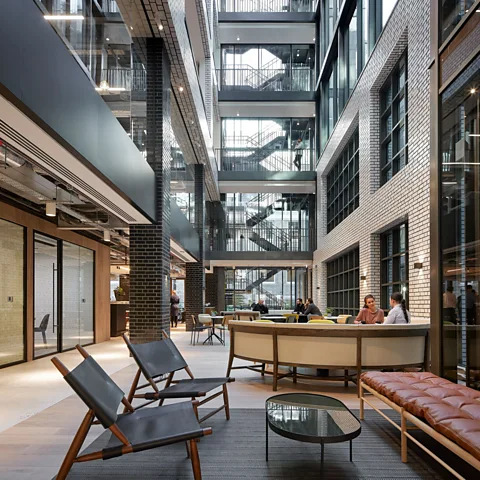As companies scramble to make inviting workspaces, they're turning to a niche swath of experts to build something special. These professionals say business is good.
One employer infuses the office with essential oils to reduce employees' stress levels. Another tweaks workplace acoustics, using insulation to find the perfect balance between quiet and community. Across town, another evaluates how office colour schemes might impact productivity, offering employees the chance to work in a "blackout" room with an entirely black colour scheme, or a corresponding "whiteout" room, to see which might spur innovation.
Each of these workplace experiments started as a recommendation from a corporate consultant. Workplace-design experts have been around for decades, but a new super-niche has popped up within the industry to help companies transform their physical spaces in the wake of the pandemic, especially as workers resist calls back to the office (at least as much as they can).
Sometimes called "workspace change management specialists", "office experience architects" or "human capital specialists", these highly-specialised roles are brand new. And leaders are willing to pay for their services.
Building a tempting office
"Two out of three organisations are either looking at redesigning the corporate real estate function or anticipating changes in the future," says Georgina Fraser, head of human capital at global commercial real-estate firm CBRE.
Companies are clamouring for a different type of guidance from experts like Fraser, who consults on everything from personalised workplace food options, to hybrid worker-friendly connectivity solutions. "If you think about consultants, we're essentially helping solve problems that you don't have answers for – things you don't have a blueprint for," says Fraser. "[Corporate] real estate is now tackling problems it hasn't tackled before."
 Courtesy of CBRE
Courtesy of CBRE"People want more now," adds Linda Morey-Burrows, the founder of London-based architecture and interior-design practice MoreySmith, who has seen a notable shift in her clients' needs in the wake of the pandemic. "In London, the commute can be long, arduous and very expensive. So, to make it worthwhile coming into the office, [workers'] expectations are high."
To make the office appealing to even the most resistant workers, Fraser says they're also getting creative with their spaces. She points to a recent client's use of facial recognition technology to ensure that employees' favourite coffee orders were prepared as soon as they stepped through the door. "We're seeing employers experiment with [space] and collect the data, so they can go back and say, 'Hey, these changes really worked'," she says.
While Morey-Burrows has worked with corporate clients for decades, she considers employers' current needs to be an entirely new frontier. She notes employees now "want to come into a space that is as comfortable as home", while also benefiting from office-specific offerings – for example, ergonomic chairs, advanced workplace technology and tempting bonuses like free meals.
What a worker wants, what a worker needs
The practical considerations of the workday are changing, too. Workplace technology design – things like secure servers to remote call-in capabilities – can make or break an employee's in-person experience, says Lewis Beck, who leads CBRE'S European Workplace Advisory team.
"The format of work has changed," says Beck, citing massive shifts in clients' needs during his eight-year tenure as head of Workplace Advisory. "If you can't find the right space to be able to take your calls, or if the office environment is noisy, or if you can't have access to private spaces [from which] to conduct meetings, or if your space doesn't enable effective or equitable hybrid meetings, then that causes friction in your everyday work experience."
Today's offices need to be comfortable – but they should also anticipate and avoid employee pain points including inconveniences like noise, fluctuating temperatures, technology glitches and even odours. "It goes so far beyond carpet, tile, desks," says Morey-Burrows. "We work with [companies] who need a real investment in design – either a building that needs a creative solution, or for building occupiers who really need to provide a workplace that supports their teams."
More like this:
"We're also seeing those spaces become more vibrant and magnetic," adds Fraser. Depending on a client's resources, this might involve adding more colour and greenery to make collaborative spaces more welcoming – or, in the case of CBRE's London headquarters, designed by Morey-Burrows and dubbed Henrietta House, it might involve placing a large, open staircase in the middle of the building, allowing for what Fraser calls "more chance encounters" that could lead to collaboration and community.
These specialised design consultants often begin their process with in-depth interviews to take stock of the company's unique needs on both an executive and support-staff level. Morey-Burrows prefers to lean on focus groups to get perspectives outside of executive steering committees; she notes employee focus groups often yield feedback that may surprise the higher-ups. "We'll come back to the [executives] and say, 'Well, remember how you said you wanted this thing? Everybody else wants all of these different things instead."
 Hufton + Crow
Hufton + CrowWorkplace consultants also rely heavily on numerical data and proprietary surveys to determine what today's workers want. "Our clients have been hugely data hungry," says Beck. "If we do research, it's got a much shorter shelf life than it ever has, because the situation is constantly changing."
Determining the future of work
Beck believes this corporate real estate and office-design consulting niche has nearly exponential growth potential.
"We're seeing a lot of diversification in the competition," he says, adding that the field has broadened to include professionals outside of traditional consultancies. "From architects providing this type of real estate, to [dedicated] workplace advisory services, all the way through to traditional consulting companies. It's a reflection of the popularity and the need for this type of advisory service."
Fraser notes that the demand is a result of the growing desire for "human-centricity" in corporate spaces – which is largely a response to companies' need to get more value out of their real estate. "In the post-pandemic period, a lot of business leaders realised that an office is just an option," says Fraser. "We don't have to have an office, but [these leaders] made a conscious decision to keep the expense of an office space."
Notes Morey-Burrows: "At the end of a project, I have people running up to me, thanking me for changing their workplace experience."
---
If you liked this story, sign up for The Essential List newsletter – a handpicked selection of features, videos and can't-miss news delivered to your inbox every Friday.


Post a Comment